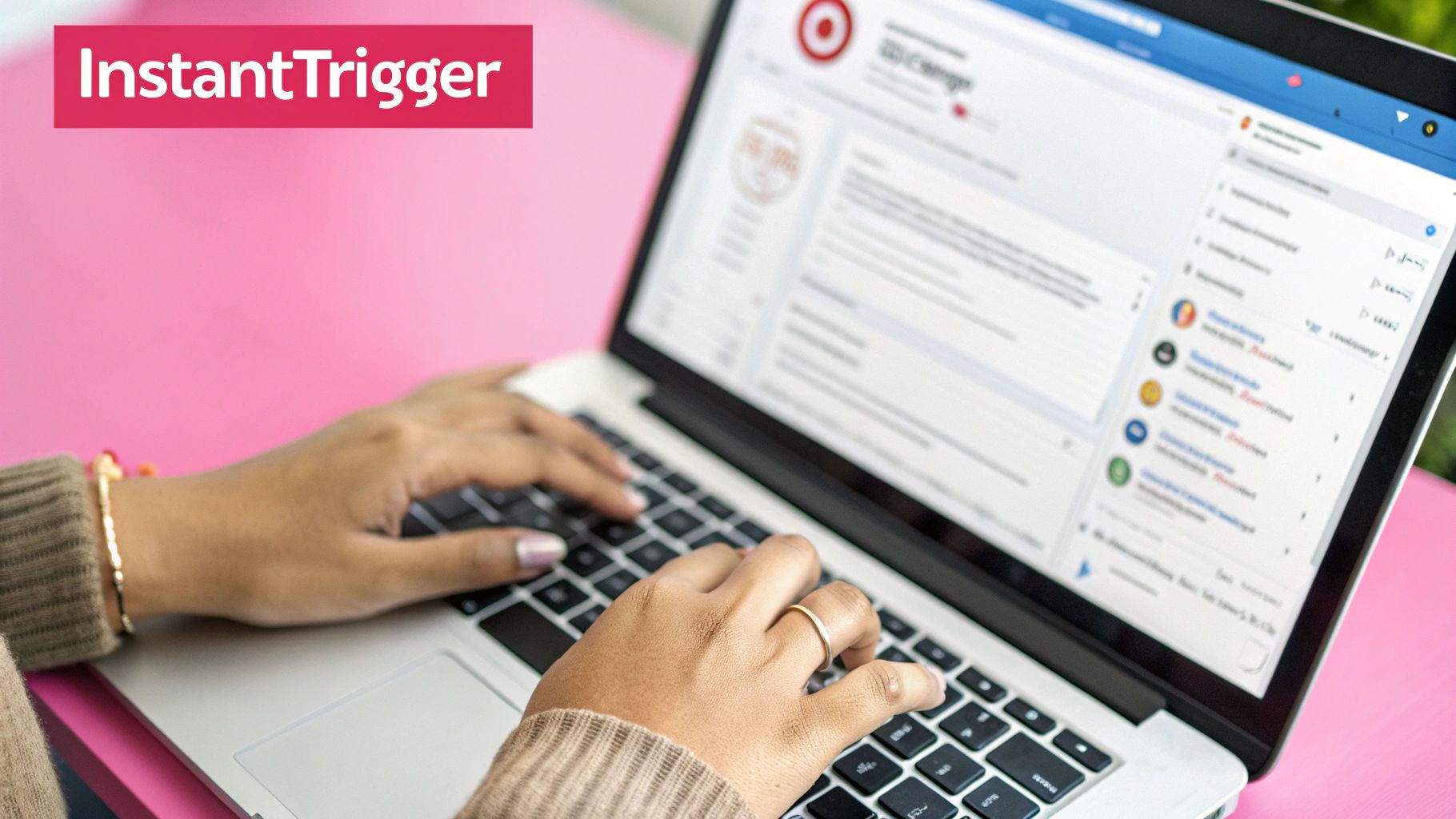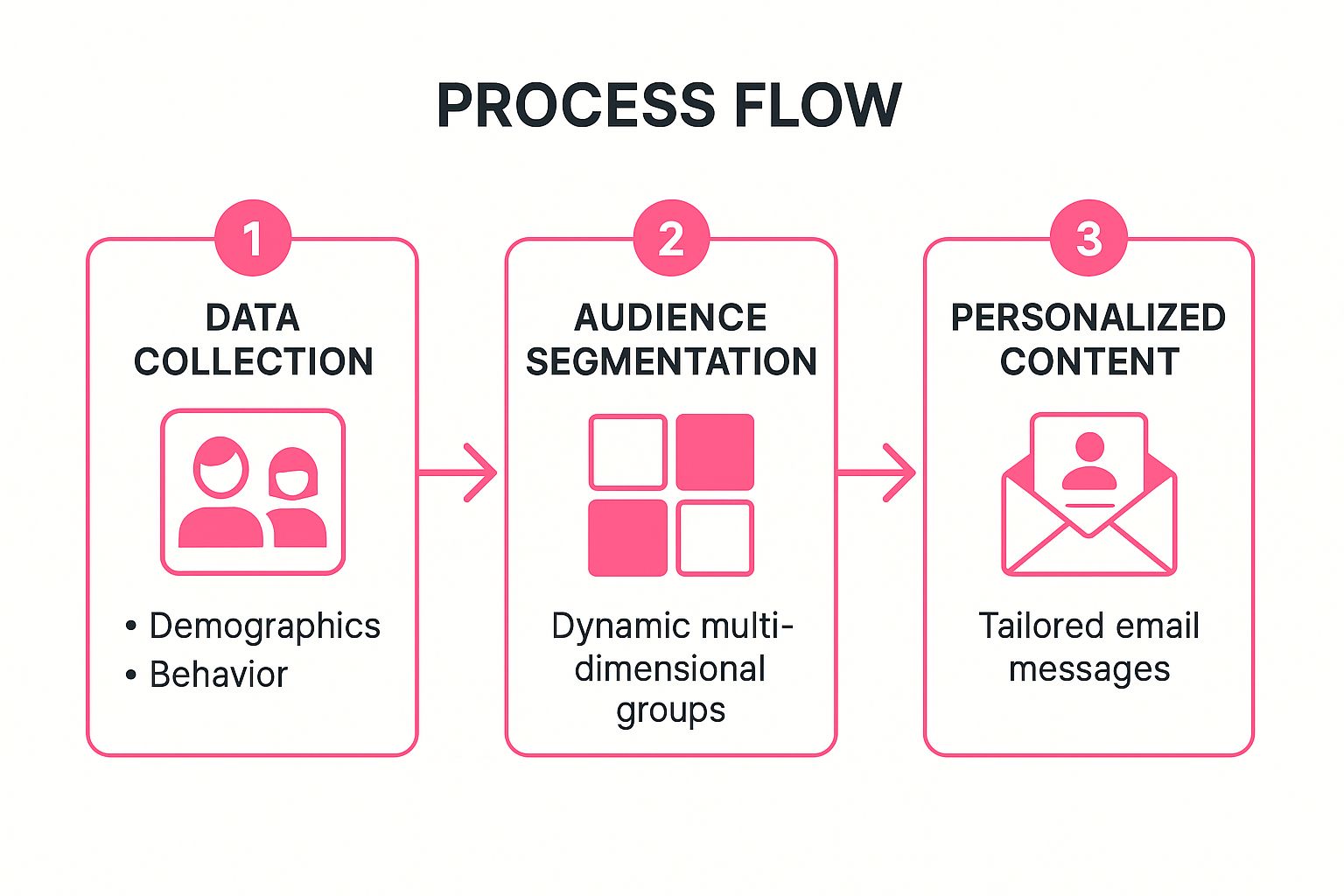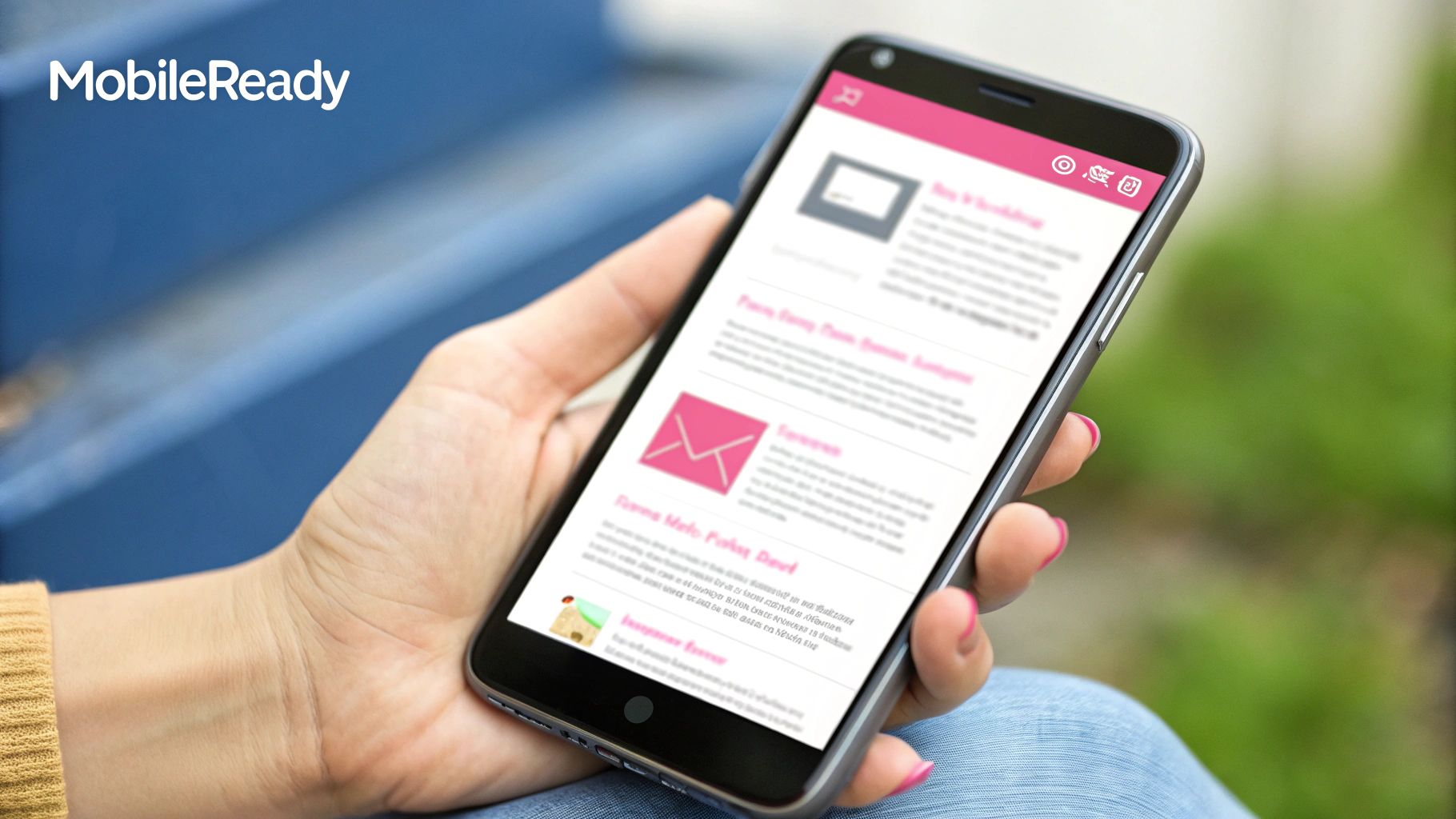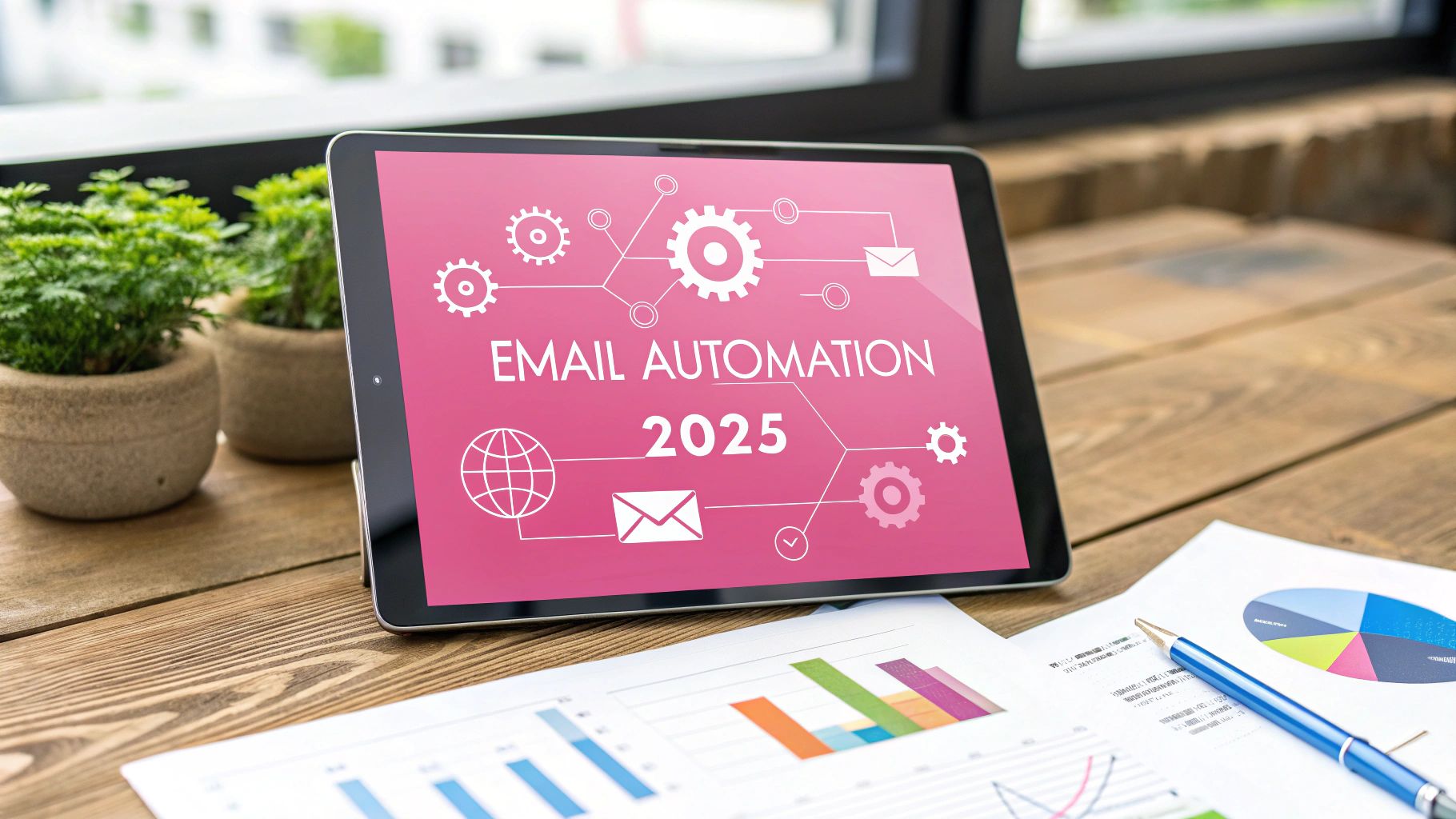Table of contents
Email automation has moved far beyond simply scheduling messages; it's now a sophisticated discipline for building genuine customer relationships at scale. For businesses like car detailers, mortgage brokers, and digital agencies, the difference between a thriving email list and a digital graveyard often comes down to strategy. Generic, impersonal blasts are out, and hyper-relevant, timely communication is in. Success isn't about sending more emails, it’s about sending the right emails at the right moments.
This article moves past the basics to explore eight advanced email automation best practices that will redefine your marketing efforts. We will provide a clear, actionable framework to help you implement these strategies effectively. You will learn how to:
- Leverage complex behavioural triggers for timely outreach.
- Master advanced segmentation to deliver truly personalised content.
- Optimise drip campaigns for maximum impact and conversion.
- Implement robust data hygiene to improve deliverability and engagement.
Prepare to transform your automated emails from background noise into valuable, revenue-driving conversations. These techniques will equip your business with the strategies needed not only to boost engagement but also to build lasting customer loyalty and a stronger bottom line.
1. Behavioural Trigger-Based Automation: The Art of Perfect Timing
Moving beyond generic, scheduled email blasts is one of the most critical email automation best practices for modern businesses. Behavioural trigger-based automation is the art of sending the right message at the perfect moment by responding directly to a user's actions. Instead of relying on arbitrary timelines, this strategy uses specific subscriber behaviours like website page visits, product views, content downloads, or cart abandonment to initiate a highly relevant, automated email sequence.

This approach transforms your email marketing from a monologue into a dynamic conversation. For example, a buyer's agent could automatically send a follow-up email with similar listings when a prospect views a specific property on their website three times. Similarly, a digital agency could trigger an email offering a free consultation when a potential client downloads a case study about SEO services. This timeliness and relevance lead to significantly higher engagement and conversion rates because the communication directly addresses the subscriber's immediate interests.
How to Implement Behavioural Triggers
Getting started with this powerful technique is more accessible than it seems. Platforms like HubSpot and Klaviyo have popularised these workflows, making them a cornerstone of effective marketing.
- Start Simple: Begin with foundational triggers. An abandoned cart sequence is a must-have for e-commerce, while a welcome series for new subscribers is crucial for any business. You can also trigger emails based on link clicks within your newsletters.
- Set Frequency Caps: To avoid overwhelming your audience, establish rules that limit how many automated emails a single person can receive within a specific period (e.g., no more than one trigger-based email every 48 hours).
- Test Time Delays: The timing is crucial. Experiment with the delay between the user's action and the email send. An abandoned cart email might perform best after one hour, while a follow-up for a downloaded resource could be more effective after 24 hours.
- Map User Journeys: For more advanced strategies, map out multi-step customer journeys. If a user visits your pricing page but doesn't sign up, you could trigger a sequence that highlights testimonials, answers common questions, and eventually offers a limited-time incentive.
By anchoring your automation in user behaviour, you ensure your emails are not just sent, but are genuinely helpful and perfectly timed.
2. Advanced Segmentation and Personalisation
Sending a generic email to your entire list is like trying to sell snow to Eskimos; it’s inefficient and ignores individual needs. One of the most powerful email automation best practices is advanced segmentation and personalisation. This strategy involves dividing your email list into highly specific groups based on demographics, behaviour, preferences, purchase history, and engagement levels. By doing so, you can deliver content that feels personal and is directly relevant to each subscriber's interests and stage in the customer journey.
For instance, an accountant could segment their list by business type (sole trader, SME, corporation) and send tailored tax tips relevant to each structure. Similarly, a mortgage broker could create segments for first-home buyers versus investors, delivering distinct content paths for each. This level of customisation transforms your email from a broadcast into a one-to-one conversation, dramatically boosting engagement and building stronger client relationships.
The infographic below illustrates the core process flow for turning raw data into personalised communication.

This flow shows how systematic data collection is the foundation for creating meaningful audience segments, which in turn enables the delivery of highly targeted, personalised email content.
How to Implement Advanced Segmentation
Effective segmentation is a cornerstone of modern email marketing, with platforms like Mailchimp and Campaign Monitor making it easier than ever to implement.
- Start with Key Segments: Don't try to segment everyone at once. Begin with 3-5 core groups that represent your most valuable client personas, such as new leads, active clients, and past clients who may need re-engagement.
- Use Progressive Profiling: Gradually gather more data over time. Use forms and surveys to ask for information like company size or specific service interests, allowing you to refine your segments without overwhelming new subscribers.
- Combine Data Sources: Integrate your email platform with your CRM. This allows you to segment based on rich, first-party data like a client's total spend or last service date, creating opportunities for hyper-relevant upsell or maintenance reminders. If you want to learn more, there are excellent client relationship management best practices on testimonialdonut.com.
- Personalise Beyond the Name: Move past
[First Name]. Use dynamic content blocks to show different service offerings or testimonials based on a subscriber's segment. A car detailer, for example, could show a ceramic coating offer to luxury car owners and an interior detailing special to owners of family vehicles.
3. Drip Campaign Optimization: Nurturing Leads Systematically
Optimising your drip campaigns is another fundamental component of effective email automation best practices. This strategy involves creating a pre-written, sequential series of emails that are automatically sent to subscribers over a specific period. Unlike behavioural triggers, which react to individual actions, drip campaigns guide users through a predetermined journey, making them ideal for nurturing leads, onboarding new customers, or re-engaging a cold audience.

The power of drip campaigns lies in their ability to build relationships and deliver value consistently over time. For an accountant, a drip campaign could onboard a new client by explaining their processes, introducing key team members, and providing helpful tax tips over several weeks. Similarly, a car detailer might use a drip series to educate a new lead on the benefits of ceramic coating, showcasing results and building trust before making a sales pitch. This systematic approach ensures no lead is forgotten and every subscriber receives a cohesive, valuable experience. These automated sequences are a cornerstone of many successful demand generation campaigns.
How to Implement Drip Campaign Optimisation
Platforms like ActiveCampaign and ConvertKit have made it simple to build and manage sophisticated drip sequences. The key is strategic planning and continuous refinement.
- Map the Journey First: Before writing a single email, visually map out the entire subscriber journey. What is the end goal? What key information does the subscriber need at each step to move forward?
- Vary Your Content: Keep subscribers engaged by mixing up email formats. Alternate between educational content, client testimonials (social proof), promotional offers, and questions to encourage a reply.
- Test Time Intervals: The delay between emails is critical. A daily email might be perfect for a 7-day challenge but overwhelming for a long-term nurture sequence. Test sending emails every 3, 5, or 7 days to find the sweet spot.
- Include Clear Exit Ramps: Always provide an easy way for subscribers to opt out of a specific sequence without unsubscribing from all communications. This can be a link like, "Not interested in this topic? Click here to stop receiving these tips."
4. Data Quality Management and List Hygiene
Sending emails to a high-quality list is just as important as the message itself. This fundamental email automation best practice involves actively maintaining clean, accurate, and up-to-date email lists. Data quality management and list hygiene are the ongoing processes of validating, cleaning, and verifying your subscriber data to ensure your messages actually reach engaged individuals. Without it, you risk high bounce rates, damaged sender reputation, and wasted marketing spend.
This practice is the bedrock of deliverability. For instance, an accountant sending a newsletter about tax law changes needs to ensure their emails land in the inboxes of active clients, not bouncing from old, invalid addresses. Similarly, a mortgage broker using automation to nurture leads must have confidence their list is clean to avoid being flagged as spam. Effective list hygiene means better engagement, improved campaign ROI, and strong compliance with anti-spam regulations.
How to Implement List Hygiene
Integrating data quality into your automation is a non-negotiable process, with many modern platforms offering built-in tools. Services like ZeroBounce and NeverBounce have also made advanced verification accessible to businesses of all sizes.
- Implement Double Opt-In: This is your first line of defence. Requiring new subscribers to confirm their email address ensures they are real, engaged, and correctly entered their details.
- Automate Bounce Handling: Configure your email platform (like HubSpot or Mailgun) to automatically suppress hard bounces. This prevents you from repeatedly sending to invalid addresses, which protects your sender score.
- Run Re-engagement Campaigns: Don't let your list go stale. Regularly segment subscribers who haven't opened or clicked an email in 3-6 months. Send them a targeted "win-back" campaign to either re-engage them or, if they remain inactive, cleanly remove them.
- Periodically Verify Your List: For critical or large lists, use a third-party verification service before a major campaign launch. This can scrub out typos, temporary addresses, and known spam traps that have accumulated over time.
By prioritising a clean list, you ensure your carefully crafted automated messages have the best possible chance of being seen and acted upon.
5. A/B Testing and Performance Optimisation
One of the most crucial email automation best practices is moving away from a "set and forget" mentality. A/B testing and performance optimisation is the data-driven process of systematically testing different elements of your automated campaigns. By comparing two versions of an email (an 'A' and a 'B' version) with a specific audience segment, you can definitively identify which one drives better results, such as higher open rates, click-throughs, and conversions.
This method takes the guesswork out of email marketing. For instance, a mortgage broker could test a subject line focused on "Low Interest Rates" against one highlighting "Fast Pre-approval" to see which message resonates more with first-home buyers. Similarly, an accountant could test sending their automated tax reminder emails on a Monday morning versus a Thursday afternoon. This rigorous, iterative approach was famously used in Obama's 2012 campaign, which tested subject lines and content to raise an additional $690 million in donations.
How to Implement A/B Testing
Platforms like Mailchimp and Campaign Monitor have made A/B testing an accessible and essential feature for businesses of all sizes, allowing you to continually refine your automated sequences for maximum impact.
- Test One Variable at a Time: For clean, understandable results, isolate a single element for each test. This could be the subject line, the call-to-action button colour, the email copy, or the 'from' name. Testing multiple variables at once makes it impossible to know what caused the change in performance.
- Ensure Statistical Significance: Don't draw conclusions from a small sample size. Send your test to a large enough segment of your list to ensure the results are statistically significant and not just a random fluke. Most email platforms will tell you when significance has been reached.
- Prioritise High-Impact Elements: Start by testing elements that are most likely to move the needle. Subject lines and call-to-action (CTA) text often have the biggest impact on open rates and click-through rates, respectively.
- Document Everything: Keep a clear record of every test you run, including the hypothesis, the variable tested, the results, and the conclusion. This document becomes an invaluable internal resource for creating high-performing campaigns in the future.
By building a culture of continuous optimisation, you ensure your automated emails don't just run, they evolve and improve over time.
6. Mobile-First Design and Optimisation
In today's on-the-go world, failing to prioritise the mobile experience is a critical misstep. Mobile-first design is one of the most fundamental email automation best practices, acknowledging that the majority of your audience, from buyer's agents to accountants, will likely first see your message on a smartphone. This strategy involves designing your automated emails to look and function perfectly on small screens first, then ensuring they scale correctly for larger desktop displays.

This approach guarantees readability and usability for the largest segment of your audience, preventing the frustration of pinching, zooming, and struggling to click tiny links. Think of Uber's simple, mobile-optimised receipt emails or Starbucks' promotional campaigns that are built for easy tapping and scrolling. For a service-based business like a mortgage broker or digital agency, this means your automated follow-ups and nurture sequences are effortless to engage with, significantly boosting click-through rates and client responses.
How to Implement a Mobile-First Design
Adopting a mobile-first mindset is a core principle popularised by platforms like Mailchimp and Litmus. It ensures your automated communications are always accessible and effective, regardless of the device.
- Use Single-Column Layouts: This is the safest and most reliable structure for ensuring your content stacks cleanly and remains readable on any mobile screen.
- Keep Subject Lines Concise: Aim for under 40 characters. Mobile devices show far less of the subject line, so you need to capture attention immediately.
- Design for Touch: Make your buttons and calls-to-action at least 44px by 44px. This provides an ample target for fingers, avoiding frustrating mis-taps.
- Optimise Your Visuals: Compress images to reduce their file size for faster loading on mobile data networks without sacrificing too much quality.
- Prioritise Readability: Use a minimum font size of 14px for body text to ensure it's legible without requiring your subscribers to zoom in.
By building your emails for the smallest screen first, you create a seamless and professional experience that builds trust and drives action across all platforms.
7. Deliverability and Sender Reputation Management
Even the most sophisticated email automation strategy is useless if your messages land in the spam folder. This is where deliverability and sender reputation management become essential email automation best practices. Deliverability is the science and art of ensuring your automated emails successfully reach subscribers' inboxes. It involves actively managing your sender reputation, which is the score Internet Service Providers (ISPs) assign to you based on your sending habits, authentication, and recipient engagement.
This practice is the foundation upon which all other email marketing efforts are built. For instance, a mortgage broker sending automated rate updates needs to ensure those time-sensitive emails are seen, not filtered. Similarly, an accountant sending automated tax deadline reminders must have confidence they are reaching the client's primary inbox. A poor reputation can cripple your entire automation system, making your carefully crafted workflows invisible to your audience.
How to Manage Deliverability and Reputation
Proactively managing your sender health is a continuous process, not a one-time setup. Platforms like SendGrid and Mailgun offer powerful tools for this, but the core principles are universal.
- Implement Proper Authentication: Set up SPF, DKIM, and DMARC records for your sending domain. These are technical standards that prove to ISPs that you are a legitimate sender, significantly boosting your credibility and preventing spoofing.
- Maintain a Clean List: Use a double opt-in process to confirm new subscribers and regularly remove inactive or unengaged contacts. Sending emails to invalid addresses or uninterested users is a major red flag for ISPs.
- Monitor Your Scores: Regularly check your sender reputation using available tools and monitor blacklist databases. A sudden drop in open rates can be an early indicator of a deliverability issue.
- Warm Up New IPs: If you use a dedicated IP address, you must "warm it up" by gradually increasing your sending volume over several weeks. This builds a positive sending history and establishes trust with ISPs.
By focusing on these technical and strategic elements, you ensure your automated messages have the best possible chance of being delivered and seen, maximising the ROI of your efforts. You can find more information on how to manage your online reputation on TestimonialDonut.
8. Lifecycle Marketing and Customer Journey Mapping
Effective communication means delivering the right message based on where a customer is in their relationship with your business. This is the core of lifecycle marketing, a strategic approach that aligns your automated emails with the distinct stages of the customer journey, from initial awareness to loyal advocacy. This method is one of the most powerful email automation best practices because it moves beyond single actions to nurture the entire customer relationship, maximising long-term value.
Instead of a one-size-fits-all message, you create tailored sequences for each phase: awareness, consideration, conversion, retention, and advocacy. An accountant, for instance, could send educational content about tax deductions to new leads (awareness), then offer a free consultation to those who engage (consideration), and finally provide a guide on preparing for tax season to new clients (retention). This ensures subscribers receive content that is always relevant to their current needs, deepening their engagement and loyalty.
How to Implement Lifecycle Marketing
Building a successful lifecycle strategy requires a deep understanding of your customer's path. Platforms like HubSpot, Marketo, and ActiveCampaign have pioneered tools to help businesses visualise and automate these complex journeys.
- Map the Customer Journey: Start by visually outlining every touchpoint a customer has with your business, from their first website visit to becoming a repeat client. Identify the key decisions and actions that move them from one stage to the next.
- Create Stage-Specific Content: Develop content tailored for each phase. An awareness stage might use blog posts and checklists, the consideration stage could feature case studies and webinars, and the retention stage might benefit from exclusive tips and loyalty offers.
- Automate Stage Transitions: Use behavioural data (e.g., downloaded an ebook, requested a quote) and transactional data (e.g., first purchase, repeat business) to automatically move contacts between lifecycle stages in your CRM or email platform.
- Align with Other Channels: To truly automate the entire customer journey, email automation often works hand-in-hand with other tools. For a broader perspective on tools that can enhance your revenue generation and customer management, consider exploring some of the best sales apps for boosting revenue.
By focusing on the entire customer lifecycle, your email automation becomes a powerful engine for building lasting, profitable relationships.
Best Practices Comparison of 8 Email Automation Strategies
Putting Your Automation on Autopilot for Success
Mastering email automation is not a destination; it's a continuous process of refinement and evolution. We've explored the foundational pillars that transform a basic email sequence into a powerful, revenue-generating engine. True success lies in moving beyond the "set it and forget it" mentality and embracing a more dynamic, responsive approach. By weaving together these eight email automation best practices, you create a system that doesn't just send messages, but builds relationships, fosters loyalty, and drives measurable growth for your business, whether you're a mortgage broker, digital agency, or car detailer.
The journey begins by understanding that every automated interaction should feel personal and intentional. This means leveraging behavioural triggers to deliver timely content, employing advanced segmentation to speak directly to individual needs, and meticulously optimising your drip campaigns to guide subscribers seamlessly through their journey. Each practice builds upon the last, creating a sophisticated and cohesive strategy.
Key Takeaways for Lasting Impact
The most crucial takeaway is that data is the lifeblood of effective automation. This involves two key areas:
- Data Quality: Maintaining pristine list hygiene and robust data management isn't just a technical task; it's the bedrock of your entire strategy. Without clean, accurate data, even the most cleverly designed automations will fail to connect.
- Performance Data: A commitment to relentless A/B testing and performance analysis is what separates good from great. Every email you send is an opportunity to learn and improve, ensuring your strategy adapts to changing customer behaviours and preferences.
Your Actionable Next Steps
To translate these concepts into action, start small but think big. Don't feel pressured to overhaul your entire system overnight. Instead, focus on a phased implementation:
- Conduct a Health Check: Begin by assessing your current state. A comprehensive email marketing audit checklist can provide a structured framework to identify your biggest opportunities for improvement and highlight any critical issues, such as poor deliverability or outdated segmentation.
- Choose One High-Impact Area: Select one practice to master first. For many businesses, this could be implementing a behavioural trigger, like an abandoned cart sequence, or mapping out a core customer lifecycle stage.
- Measure and Iterate: Define your success metrics before you launch. Track open rates, click-through rates, conversions, and unsubscribe rates. Use this data to validate your approach and make informed adjustments.
By consistently applying these email automation best practices, you build more than just a marketing channel; you build an intelligent asset that works for your business 24/7. It’s about creating a system that not only anticipates customer needs but also delights them with relevant, valuable, and perfectly timed communication. This is how you put your growth on autopilot and achieve sustainable success.
Ready to automate one of the most powerful forms of marketing? Testimonial Donut makes it effortless to automatically request and collect customer reviews after a purchase or service. Integrate social proof into your lifecycle marketing and turn happy customers into your best advocates by visiting Testimonial Donut today.



